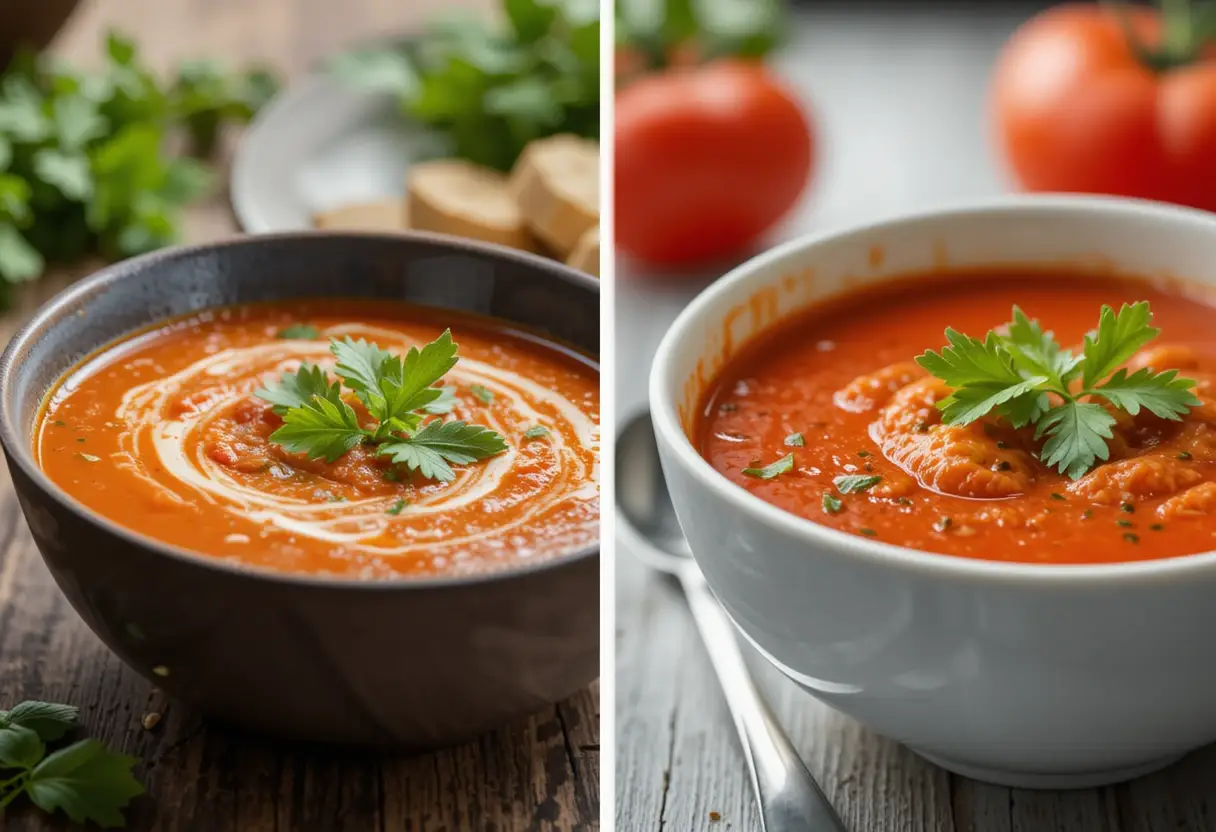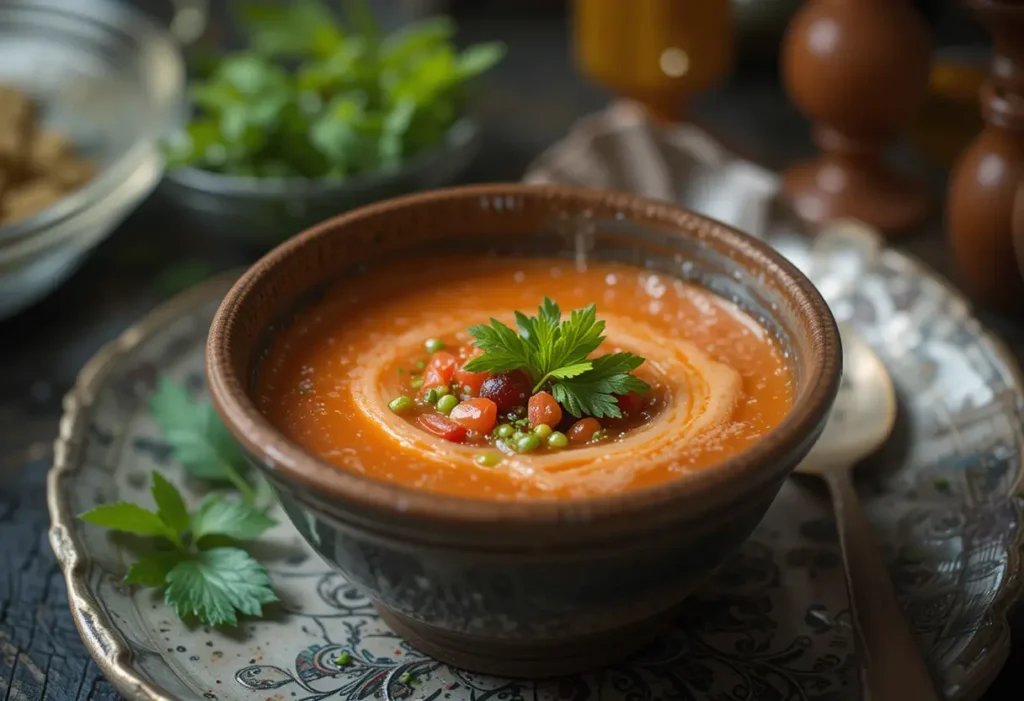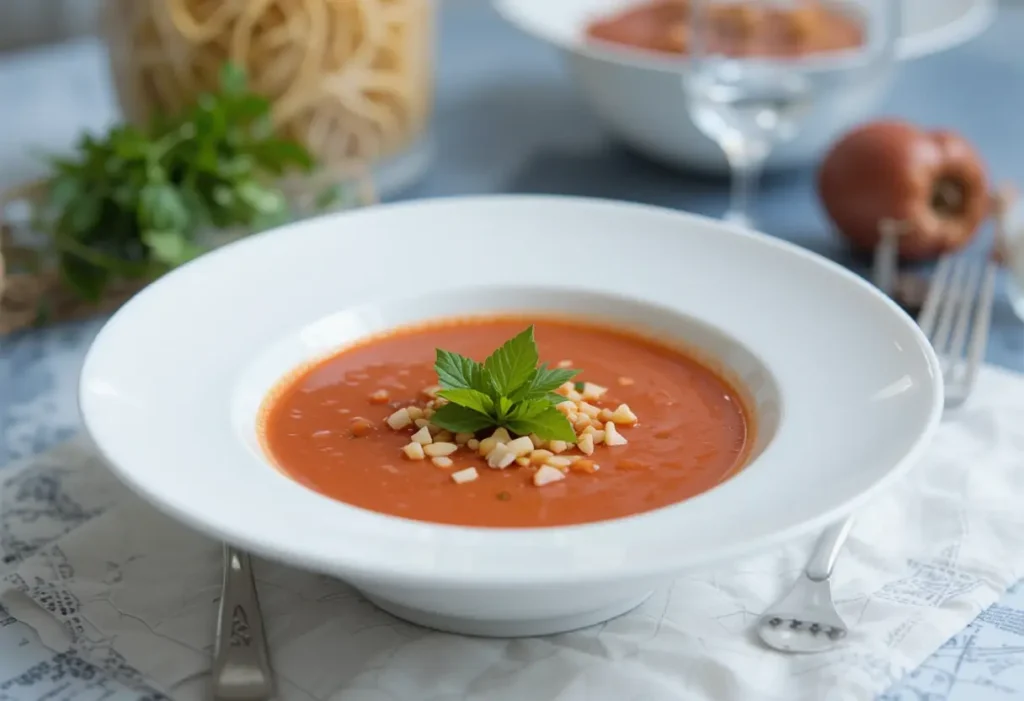Gazpacho and tomato soup are two beloved dishes that showcase the versatility of tomatoes. Is Gazpacho the Same as Tomato Soup? Not quite. Gazpacho is a cool and refreshing soup, perfect for hot weather, while tomato soup is warm and comforting, great any time of year. Both are simple to prepare, bursting with flavor, and rooted in rich food traditions, but their differences in serving style and texture make each unique.
Overview of Gazpacho
Gazpacho is a cold soup from Spain, especially the Andalusian region. It uses fresh vegetables like tomatoes, cucumbers, peppers, and garlic, blended into a smooth soup. Gazpacho is light, healthy, and hydrating, making it perfect for warm days. Olive oil and vinegar add a tangy and flavorful kick, making this soup a favorite summer dish.
Overview of Tomato Soup
Tomato soup is a warm and cozy dish loved for its simple and rich flavor. It’s made by cooking tomatoes with onions, garlic, and herbs, then blending it into a smooth texture. Some people add cream for extra richness. Tomato soup is versatile—perfect as a light starter or paired with a classic grilled cheese sandwich for a comforting meal.
Table of Contents
Origins and History
The stories of gazpacho and tomato soup show how tomatoes spread across the world, shaping different cuisines and food traditions.
History of Gazpacho
Gazpacho comes from Andalusia, Spain. It started as a simple dish made by farmers, using stale bread, olive oil, garlic, and vinegar. When tomatoes came to Europe from the Americas in the 16th century, they became a key ingredient in gazpacho. This change turned it into the bright, flavorful dish we know today. Over time, gazpacho became a famous symbol of Spanish cooking, loved for its fresh and easy recipe.
History of Tomato Soup
Tomato soup became popular in the late 1800s, especially in the U.S. and Europe. In America, it gained fame thanks to the Campbell Soup Company, which made it easy to enjoy tomato soup at home. Before that, chefs in France served tomato based soups as part of fancy meals. Over the years, tomato soup became a comforting food that people everywhere could enjoy.
Gazpacho and tomato soup may be different, but they both show how amazing and adaptable tomatoes are. These dishes are loved worldwide, proving that simple ingredients can make delicious meals.
Ingredients and Preparation
Gazpacho and tomato soup are both made from simple and fresh ingredients, but they differ in how they are prepared and enjoyed. By understanding their key components and regional variations, you can appreciate how these dishes have been adapted in different parts of the world.
Key Ingredients of Gazpacho
Gazpacho is a refreshing cold soup made from raw vegetables. Its ingredients are easy to find and combine to create a flavorful and healthy dish. Here are the main ingredients and their quantities:
- 6 ripe tomatoes (about 1.5 pounds): These form the base of the soup, adding color, sweetness, and juiciness.
- 1 cucumber (peeled and diced): This ingredient gives the soup a fresh and crisp texture.
- 1 red bell pepper (seeded and chopped): It adds a touch of sweetness and a slight crunch to the dish.
- 2 cloves of garlic (minced): Garlic gives the soup a bold and aromatic flavor.
- 1/4 cup olive oil: Olive oil makes the soup smooth and enhances its richness.
- 2 tablespoons vinegar or lemon juice: This provides a tangy and slightly sour taste that balances the flavors.
- 1 cup stale bread (optional): Bread can be added to make the soup thicker and creamier.
- 1/2 teaspoon salt (or to taste): A small amount of salt boosts the overall flavor.
- 2 cups cold water (as needed): Water helps adjust the consistency to your liking.
Variations Across Spain
Gazpacho changes slightly from one region in Spain to another. For example:
- Andalusian Gazpacho: This is the classic version that uses the ingredients mentioned above.
- Salmorejo: This version, from Córdoba, is thicker because it uses more bread. It is often topped with boiled eggs and diced ham, though halal versions leave out the ham.
- Ajoblanco: Unlike other gazpacho recipes, this one skips the tomatoes. It is made with almonds, garlic, bread, and olive oil, creating a creamy white soup that’s also refreshing.
Key Ingredients of Tomato Soup
Tomato soup is a warm and comforting dish made by cooking a few basic ingredients together. Its smooth texture and rich flavor make it a favorite. Below are the essential ingredients and their typical amounts:
- 6 medium-sized tomatoes (or 28 ounces of canned tomatoes): Tomatoes are the main ingredient and provide a tangy and slightly sweet flavor.
- 1 medium onion (chopped): The onion adds a mild sweetness and helps balance the tanginess of the tomatoes.
- 2 cloves of garlic (minced): Garlic enhances the soup’s flavor with a light spicy kick.
- 2 cups vegetable or chicken stock: Stock makes the soup more flavorful and satisfying.
- 1/4 cup heavy cream (optional): Adding cream makes the soup richer and smoother.
- 2 tablespoons olive oil or butter: These are used to sauté the onions and garlic, which deepens their flavors.
- 1 teaspoon sugar (optional): Sugar helps reduce the acidity of the tomatoes and creates a balanced flavor.
- 1/2 teaspoon salt and pepper: These seasonings are added to taste for the perfect final touch.
Variations in Different Cultures
Tomato soup has been adapted in many countries, with each culture adding its unique twist. For instance:
- American Tomato Soup: This version is typically creamy and smooth, often paired with grilled cheese sandwiches for a classic combination.
- Indian Tomato Soup: In India, tomato soup is spiced up with ingredients like cumin, turmeric, and coriander. A touch of chili powder gives it a spicy kick.
- Italian Tomato Soup: Italian versions often feature garlic, basil, and Parmesan cheese for a Mediterranean flavor. Some hearty recipes, like pappa al pomodoro, add bread for a thicker texture.
Gazpacho and tomato soup might be different, but both are versatile and delicious. With a few simple ingredients and some creativity, you can enjoy these dishes in their classic form or adapt them to suit your taste and style.
Nutritional Comparison
Gazpacho and tomato soup both offer great health benefits, but their nutritional profiles vary based on ingredients and preparation. By exploring their specific advantages, you can better decide which suits your dietary needs.
Health Benefits of Gazpacho
Gazpacho is an excellent choice for those seeking a light, refreshing meal packed with nutrients. Because it is made with fresh vegetables and served raw, it retains many of its natural vitamins and minerals.
- High in Vitamins: Gazpacho provides vitamins A, C, and E, which boost immunity and promote skin health. For more vitamin rich meals, check out Southern Cornbread Recipes.
- Loaded with Antioxidants: Tomatoes and garlic in gazpacho are rich in antioxidants like lycopene, which help reduce inflammation and protect against diseases.
- Hydrating: With its high water content, gazpacho is a great way to stay hydrated during hot weather.
- Low-Calorie Option: Gazpacho is light and ideal for weight loss or maintenance diets.
Health Benefits of Tomato Soup
Tomato soup is another healthy option that combines warmth and nourishment. Its cooked ingredients make it a comforting and versatile dish.
- Rich in Lycopene: Tomatoes in the soup are a powerful source of lycopene, an antioxidant that supports heart health and may reduce cancer risks. Learn more about lycopene in Chilean Tomato Stew.
- Good for Digestion: Tomato soup can provide dietary fiber, especially when paired with whole-grain bread or added vegetables.
- Immune Support: Vitamins C and A in tomato soup strengthen the immune system and promote good vision.
- Customizable Nutrition: Add cream or protein to increase its nutritional value and make it more filling.
Culinary Uses
Gazpacho and tomato soup are versatile dishes that can be adapted for various occasions. While gazpacho shines in refreshing starters, tomato soup pairs well with hearty meals.
Traditional Uses of Gazpacho
Gazpacho has long been a favorite dish in Spanish cuisine, especially during the summer. It is often served as a light meal or appetizer at family gatherings and festivals.
Modern Twists on Gazpacho
Today, gazpacho has inspired creative recipes worldwide:
- Fruit Variations: Chefs often replace tomatoes with watermelon or strawberries for a sweeter twist.
- Seafood Additions: Adding shrimp or crab makes gazpacho more filling and suitable as a main course.
- Spicy Versions: Ingredients like jalapeños or hot sauce bring a bold flavor to traditional gazpacho.
- Smoothie-Style Bowls: Garnish with diced vegetables and fresh herbs for a modern, Instagram-worthy presentation.
Traditional Uses of Tomato Soup
Tomato soup is a global comfort food, traditionally served as a starter or a light meal. It’s also a perfect pairing for other popular dishes.
Pairings and Recipes Involving Tomato Soup
Tomato soup pairs well with a variety of foods, creating balanced meals:
- Grilled Cheese Sandwiches: A classic combination for a cozy and satisfying meal.
- Crunchy Toppings: Croutons or breadsticks add texture to the smooth soup.
- Hearty Additions: Pasta, rice, or beans make tomato soup filling and versatile.
- Global Flavors: Try adding spices or herbs to create unique versions, like those seen in Vegetarian Lasagna Soup.
Cultural Significance
Both gazpacho and tomato soup hold a special place in food traditions and popular culture, reflecting their unique origins and widespread appeal.
Gazpacho in Spanish Festivals
In Spain, gazpacho plays a central role in cultural celebrations:
- Summer Festivals: Many Andalusian festivals serve gazpacho as a refreshing treat for attendees.
- Cooking Contests: Some events feature gazpacho competitions, celebrating local culinary traditions.
- Cultural Events: Gazpacho is often showcased at events promoting Spanish heritage, highlighting its historical importance.
Tomato Soup in Popular Culture
Tomato soup is an iconic dish, especially in Western culture:
- Comfort Food Symbol: In the U.S., it’s a nostalgic dish, often paired with grilled cheese sandwiches for a classic comfort meal.
- Art and Media: Andy Warhol’s “Campbell’s Soup Cans” artwork turned tomato soup into a cultural icon.
- Movies and TV: Tomato soup frequently appears in scenes depicting warmth and family gatherings.
- Global Recognition: Its adaptability has made it a favorite worldwide, as seen in dishes like Macaroni and Tomatoes.
By exploring these dishes’ health benefits, culinary uses, and cultural significance, you can see why gazpacho and tomato soup remain timeless favorites.
FAQs About ( Is Gazpacho the Same as Tomato Soup ?)
1. How is gazpacho different from tomato soup?
Gazpacho is a cold Spanish soup made from raw vegetables like tomatoes, cucumbers, and peppers. It’s refreshing and perfect for hot weather. On the other hand, tomato soup is warm and creamy, making it a comforting choice for colder days. Both are delicious but enjoyed in very different ways.
2. Can I make vegan versions of gazpacho and tomato soup?
Yes, you can easily make both soups vegan. Gazpacho is already vegan because it uses raw vegetables and olive oil. For tomato soup, you can replace chicken broth with vegetable broth and skip cream or cheese toppings. This way, both dishes can suit a vegan diet.
3. What are some creative twists on these soups?
There are many ways to get creative with gazpacho and tomato soup. For gazpacho, try making a fruit version with watermelon or strawberries for a sweet and tangy flavor. For tomato soup, add spices or serve it with a grilled cheese sandwich for a classic, satisfying meal. If you want to explore more soup ideas, check out Chilean Tomato Stew.
4. Can I freeze gazpacho or tomato soup?
Yes, freezing is a great option for these soups. Tomato soup freezes well and lasts up to three months. Gazpacho can also be frozen, but the texture of the vegetables may change after thawing. For the best flavor, enjoy gazpacho fresh when possible.
5. What foods go well with gazpacho or tomato soup?
Gazpacho goes well with light and fresh sides like bread or a crisp salad. Tomato soup pairs beautifully with grilled cheese sandwiches, croutons, or even pasta for a hearty meal. For more ideas, explore this recipe for Vegetarian Lasagna Soup.
These FAQs show how gazpacho and tomato soup can fit into different meals and diets, making them versatile and easy to enjoy.
Conclusion: Summing Up the Differences
Gazpacho and tomato soup may share tomatoes as a key ingredient, but their differences make each dish unique. Gazpacho is a chilled, refreshing soup made from raw vegetables, making it perfect for hot weather or as a light appetizer. In contrast, tomato soup is warm, creamy, and comforting, ideal for colder days or when paired with hearty sides like grilled cheese sandwiches.
Nutritionally, gazpacho is a low-calorie dish packed with hydrating ingredients and raw nutrients. You can explore other refreshing recipes like Vegetarian Lasagna Soup. Tomato soup offers richness and flexibility, allowing additions like grains or proteins to enhance its heartiness, similar to this Chilean Tomato Stew.
Culturally, gazpacho represents Spanish traditions, often served at festivals, while tomato soup is a global comfort food celebrated in art and media. Both showcase the versatility of tomatoes and their timeless appeal in cuisines worldwide.



